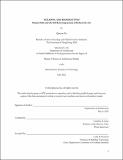"Scraping and Bloodletting": Xiamen Dada and the Self-Renewing System of Reform-Era Art
Author(s)
Xu, Qianyue
DownloadThesis PDF (87.21Mb)
Advisor
Jones, Caroline A.
Terms of use
Metadata
Show full item recordAbstract
In 1986, Dada rhetoric surfaced in the coastal city of Xiamen in southeast China to be taken up by the art collective Xiamen Dada (xiamen dada 厦门达达). Active between 1986 and 1989, the collective targeted agents in the institutional framework of art. Their activities included a burning event where they disassembled their previously exhibited artworks and set them on fire in front of the museum; a “surprise attack” in the form of a ready-made exhibition where they moved objects found around the museum into the building and called that an “event exhibition”; and a project blueprint for pulling the National Art Museum of China with four thousand meters of hemp rope.
This thesis deconstructs Xiamen Dada’s much-heralded radicality as exchanges, negotiations, and engineered equilibrium between control and calculated freedom in the self-renewing system that was reform-era art in China. This is done by dismantling the false dichotomy between the supposedly monolithic art establishment and the radical avant-garde which is thought to work outside its set constraints. I open with an interrogation of the dynamic canonization of Luo Zhongli’s 罗中立 Father (fuqin 父亲, 1980), made around the time the collective’s de facto leader Huang Yong Ping 黄永砅 produced his audacious thesis project The Spray Gun Series (penqiang xilie 喷枪系列, 1981). I argue that the discourse of tolerance that produced this process exemplifies the symbiotic relationship between the Chinese art establishment and limited deviations from artistic canon that provide opportunities for calculated self-renewal. I then compare Xiamen Dada’s trajectory vis-à-vis art museums with that of the Stars (xingxing 星星), highlighting the enabling role played by sympathetic gatekeepers of the art establishment in both groups’ interventions and the obscured fact that Xiamen Dada accessed and capitalized on material resources and networks provided by the art establishment. I push this observation further to expose Xiamen Dada’s collectivism as a survival strategy and problematize the concept of collectivity.
The radicality of Xiamen Dada lies not in the illusory breakaway from the art establishment, but in their repeated testing and recalibration of the optimal amount of stress that would stimulate the body of the art establishment to seek out a new form of health without triggering a complete destruction of its unity. Recuperation, reintegration, and reconfiguration—these are the vocabularies of reform.
Date issued
2022-05Department
Massachusetts Institute of Technology. Department of ArchitecturePublisher
Massachusetts Institute of Technology